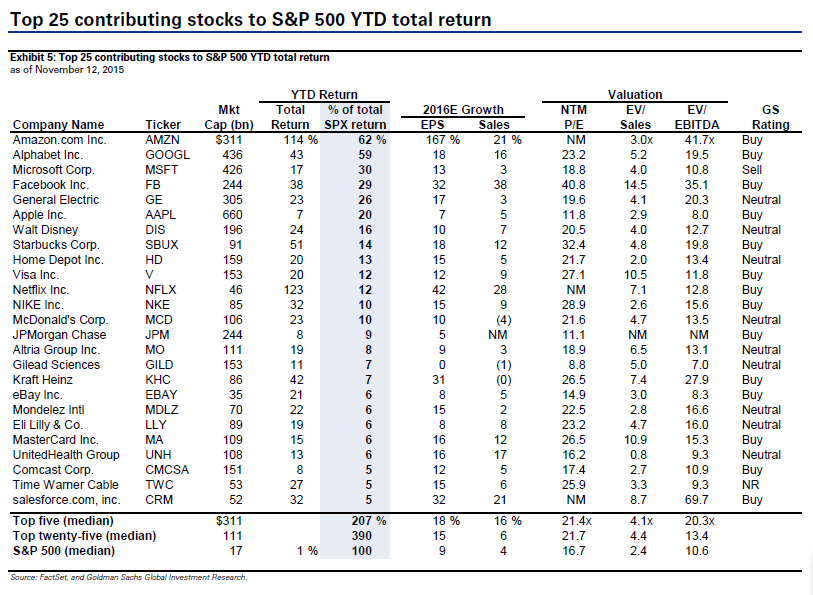The stock market is starting to show signs of exhaustion and it may be a good time to rebalance your portfolio and make sure you are comfortable with the amount of risk you are taking in your investment allocation. There are several signs of exhaustion in the market.
The first is that the S&P 500 has advanced and hit a barrier around 2100 having yet to reach 2150 this year. I don’t generally put much weight into levels in an index but it is undeniable that there is some behavioral psychology with index numbers. In general, when the market corrects, it will hit a barrier, come down and then hit it again before entering a real “correction.” This type of pattern happened in 2007 and while this market is very different than 2007 we have hit a top, come off of it and hit it again a few months later. We’re ready for a slippery move down and that would be “normal” for the market.
Secondly, the market is characterized by a narrow breadth, meaning only a few stocks are driving the index-level return, and without these stocks the market return would be lower. Goldman Sachs in their November 13th research note, “US Weekly Kickstart” pointed out that only five firms have accounted for over 100% of the S&P 500 YTD return. That isn’t saying much as the YTD return as of November 13th is 0.06% but without Amazon, Alphabet (formerly Google), Microsoft, Facebook, and GE, the S&P 500 would be 2.2% lower. This same lack of market breadth happened in both the late 90s and 2007. I remember mega cap stocks – the largest companies in the world – were positive double digits while the rest of the market was positive single digits that year. A market environment that lacks breadth often favors stocks with positive momentum and we’ve seen that. Combined with the fact that this often happens at the end of bull market cycles, this appears to be a warning sign.
Thanks to twitter for this image, unfortunately I can't remember the poster for credit. Mega cap stocks are outperforming smaller stocks through each time frame in 2015.
Thirdly, import activity is down and retailers are reporting excess inventory. According to the Wall Street Journal, imports fell in both September and October at the three busiest U.S. seaports by just over 10%. Additionally, Macys and Kohls reported 3rd quarter results and brands like Micheal Kors and Ralph Lauren have backlogs of their goods. Part of the reason for these import and inventory issues is cyclicality, the holiday shopping season is coming and stores are already prepared but another possible issue is that the U.S. consumer is wary of spending, which is consistent with the global economic slowdown.
Finally, low energy prices have resulted from an over-investment in oil and gas, particularly fracking, and the strong dollar is impacting commodities prices. Energy and commodities are in a self-regulating cycle, and when there is too much production of a commodity and the price declines there is less incentive to mine or produce it, and the price rises. While this works in a simple system when you add uneconomic incentives like political use of a commodity (OPEC not decreasing production to maintain a price but instead maintaining output) it causes a problem. Many oil and gas and commodity companies invested with the expectation that prices would rise with inflation or other cuts in production and that didn’t happen for many reasons. Now many of those companies are facing very difficult environment. Many will have to merge, fold, or seek outside investment to continue operations and it will impact the overall market and the future price of energy and commodities.
The market may correct many of these issues and continue to grow. Goldman Sachs in the same market comment anticipates the S&P 500 will be at 2075 in 12 months. That’s a 1.7% gain over a year. That is not a ringing endorsement but neither is it negative. It is possible that breadth will return to the market and the holiday season will bring the American consumer out in force and the energy mal-investment will be worked off without hindering the overall market, and we’re able to avoid an overdue market correction. It’s possible so proceed with caution. Caution means doing what you ought to be doing anyway and not being greedy. Be diversified and have enough cash in your emergency fund and cash available for your expected expenses beyond cash flow over the next three years. Make sure you have some conservative investments you can reallocate if the market declines by 20% and don’t be surprised to see some volatility over the next year. Don’t worry, we’ll get through this, too. If you have any questions or concerns, don’t hesitate to contact me.




